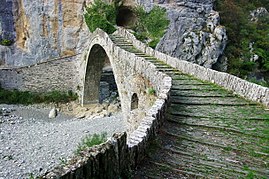Zagori
|
Zagori Ζαγόρι |
|
|---|---|
 |
|
| Coordinates: 39°52′N 20°42′E / 39.867°N 20.700°ECoordinates: 39°52′N 20°42′E / 39.867°N 20.700°E | |
| Country | Greece |
| Administrative region | Epirus |
| Regional unit | Ioannina |
| Area | |
| • Municipality | 989.8 km2 (382.2 sq mi) |
| Population (2011) | |
| • Municipality | 3,724 |
| • Municipality density | 3.8/km2 (9.7/sq mi) |
| Time zone | EET (UTC+2) |
| • Summer (DST) | EEST (UTC+3) |
| Vehicle registration | ΙΝ |
Zagori (Greek: Ζαγόρι), is a region and a municipality in the Pindus mountains in Epirus, in northwestern Greece. The seat of the municipality is the village Asprangeli. It has an area of some 1,000 square kilometers and contains 46 villages known as Zagori villages (or Zagorochoria or Zagorohoria), and is in the shape of an upturned equilateral triangle. The southern corner of the triangle contains the provincial capital, Ioannina, the south-western side is formed by Mount Mitsikeli (1,810m), and the Aoos river and Mount Tymfi constitute the northern side, and the south-eastern side runs along the Varda river to Mount Mavrovouni (2,100m) near Metsovo. The municipality has an area of 989.796 km2. The population of the area is about 3,700, which gives a population density of 4 inhabitants per square kilometer, compared to an average of 73.8 for Greece as a whole.
Zagori is an area of great natural beauty, with striking geology and two National Parks, one including the river Aoos and the Vikos Gorge, the other around Valia Kalda, to the east of the imposing snow-capped Mt Tymphe. The 46 or so villages of Zagori were interconnected by mountain roads and traditional arched stone bridges until modern roads were opened in the 1950s. The stone arched bridges were built by benefactions from expatriate merchants in the 18th century and replaced older wooden bridges.
The region has been historically difficult to access due to its mountainous terrain; this contributed to its security and stability rather than being a disadvantage. The Sarakatsani people who can be found in this area use several Greek words of a Northern Greek dialect not commonly found in Greek elsewhere. They are consequently considered by some as indigenous to the area.
The first evidence of human presence in the area is dated between 17,000 and 10,000 years ago. Important epipaleolithic artifacts have been unearthed from Kleidi Cave on the banks of Voidomatis. In antiquity, the region of Zagori was inhabited by the Tymphaeans and formed a part of the ancient kingdom of the Molossians, a Greek tribe of Epirus that gained control over all of Epirus in classical times. They were known for a breed of huge war-mastiffs they used in military operations. Molossus, their eponymous ancestor, was said to have been born of a union between Neoptolemus (son of Achilles ) and Andromache (the wife of Hector of Troy). Neoptolemus, also called Pyrrhus for his blond hair, was first in a line of Epirotan kings leading to the king Pyrrhus of Hellenistic times who launched several campaigns against the Romans in Italy. Olympias, the mother of Alexander the Great, was from the ancient town of "Molossis" which was located in the area in front of Konitsa, in the northern boundary of Zagori, where the rivers Voidomatis, Aoös and Sarantaporos come together. Remains of cyclopean walls in Skamneli also testify to the antiquity of human occupation. During the 9th–4th centuries B.C., a small Molossian settlement existed between Monodendri and Vitsa, including stone houses and two cemeteries which have yielded important findings. However, throughout most of the historical time the local population was sparse while the land provided mainly for pastoralism and firewood for the local needs.
...
Wikipedia


